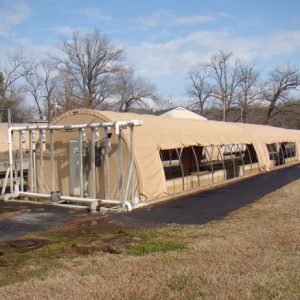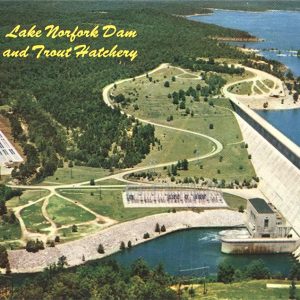calsfoundation@cals.org
National Fish Hatcheries
Thirty-five states are home to a total of seventy national fish hatcheries (NFHs). Arkansas is home to three: Mammoth Spring, Norfork, and Greers Ferry. Arkansas’s role in the federal fish hatchery system—designed to conserve, protect, and enhance the fish population nationwide for the benefit of all Americans—is key. Arkansas is the systems leader in trout production, has the single Gulf Coast striped bass facility in the world, and engages universities in collaborative research efforts.
The United States Fish and Wildlife Service (USFWS) in the Department of the Interior administers the world’s largest fish hatchery system, comprising not only hatcheries, but also Fish Health Centers and Fish Technology Centers. Federal fish hatcheries trace their formation to a joint resolution of the Forty-first Congress directing the government to ascertain “whether any diminution in the number of food fishes of the coast and lakes of the United States has taken place; and, if so, to what causes the same is due; and also whether any and what protective, prohibitory, or precautionary measures should be adopted in the premises.” President Ulysses S. Grant signed the resolution on February 9, 1871. The next year, the first federal freshwater fish hatchery—Baird Hatchery—opened on California’s McCloud River.
Created to reverse declining native fish populations, hatcheries today “produce cultured fish to replace fish that were lost from natural (drought, flood, and habitat destruction) or human (over-harvest, pollution, habitat loss due to development and dam construction) influences to establish fish populations to meet specific management needs, and to provide for the creation of new or expanded recreational fisheries opportunities.” Fish hatcheries supplement natural propagation using artificial methods. As a rule, fish are raised in either ponds, cages or pens, or raceways—long, narrow ponds with a continuous flow of water from a spring or stream. Suspended, flexible netting cages are used in lakes or bays. Ponds are usually earthen pools. The type of system correlates to location and the species of fish raised and its special needs, such as water temperature. Regardless of the vessel used (pond, cage, raceway), fish food formulated to be high in nutrition is provided to fingerlings, and because hatchery fish do not encounter predators, they have a high rate of survival.
Mammoth Spring National Fish Hatchery (MSNFH), located in Mammoth Spring (Fulton County), was the first national hatchery established in Arkansas, dating back to 1903. It is also one of the oldest in the country. Mammoth Spring is the seventh-largest spring in the United States and the largest spring in Arkansas. The spring forms the headwaters of the Spring River. Water flows at a constant fifty-eight degrees, making it ideal for the production of cool-water fish. Gravity forces the water through raceways and fills ponds, returning most to the Spring River. The hatchery uses both naturally spawning broodfish and eggs collected from adult fish netted in the wild, adding hormones and using incubator jars. The hatchery is involved in the restoration of paddlefish, sturgeon, walleye, smallmouth and largemouth bass, bluegill, and Gulf Coast striped bass—the only captive spawning population in the world. In a cooperative endeavor with Arkansas State University (ASU), the hatchery is working on the recovery of endangered and threatened freshwater mussels. Annually, the MSNFH is responsible for stocking an average of 40,000 paddlefish, 2,500 sturgeon, 400,000 walleye, 100,000 smallmouth bass, 100,000 largemouth bass or bluegills, 5,000 freshwater mussels, and two million striped bass.
Norfork National Fish Hatchery (NNFH), a cold-water facility, is located in Mountain Home (Baxter County) on the White River. Norfork Dam (completed in 1944) and Bull Shoals Dam (completed in 1951), both on the White River, increased the need for this hatchery, which was established in 1955 and opened on August 15, 1957. NNFH is the largest-producing federal hatchery and is the largest trout hatchery in the country. NNFH receives hatchery-fertilized eggs, raising the fish to nine inches before release. Annually, over two million rainbow, cutthroat, and brown trout are released.
Greers Ferry National Fish Hatchery (GFNFH), another cold-water facility, is located in Heber Springs (Cleburne County) and was established in 1965 to mitigate the Greers Ferry Dam’s impact on the Little Red River. Cold hatchery water comes from 100 feet below the reservoir surface and has an average temperature of forty-four to fifty-six degrees. Flowing through the hatchery at 15,000 gallons per minute, the water is ideal for raising rainbow and brook trout. GFNFH does not have broodstock of its own but receives hatchery-fertilized eggs from Tennessee, West Virginia, and Montana, raising the trout to eleven inches before their release. Annually, one million trout are released for stocking, with an average of 182,000 released back into the Little Red River.
With 600,000 acres of lakes and 9,700 miles of streams, Arkansas is home to 215 species of fish, of which 197 are native. More than 20 million fish a year (including trout) are stocked in Arkansas. More than half those who fish for Arkansas trout come from out of state.
USFWS works with states by providing financial support for state fish programs using funds from sporting-goods taxes. The Arkansas Game and Fish Commission (AGFC) has nine state-owned facilities: four warm-water fish hatcheries in Hot Springs (Garland County), Centerton (Benton County), Lonoke (Lonoke County), and Corning (Clay County); two cold-water hatcheries in Mammoth Spring and Diamond City (Boone County); and three pen or caged facilities in Mount Ida (Montgomery County), Mena (Polk County), and Yellville (Marion County).
For additional information:
Greers Ferry National Fish Hatchery. http://www.fws.gov/greersferry/ (accessed August 26, 2023).
Mammoth Spring National Fish Hatchery. http://www.fws.gov/mammothspring/ (accessed August 26, 2023).
National Fish Hatchery System. United States Fish and Wildlife Service. http://www.fws.gov/fisheries/nfhs (accessed August 26, 2023).
Norfork National Fish Hatchery. http://www.fws.gov/norfork/ (accessed August 26, 2023).
Schnedler, Jack. “Huge Fish Hatchery Has Plethora of Delights for Visitors.” Arkansas Democrat-Gazette, May 24, 2018, p. 5E.
Sutton, Keith, ed. Arkansas Wildlife: A History of the Arkansas Game and Fish Commission. Fayetteville: University of Arkansas Press, 1998.
John Spurgeon
Bella Vista, Arkansas








Comments
No comments on this entry yet.